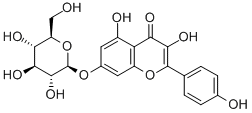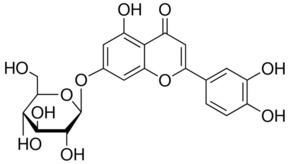Classification Glycoside | ||
 | ||
A glucoside is a glycoside that is derived from glucose. Glucosides are common in plants, but rare in animals. Glucose is produced when a glucoside is hydrolysed by purely chemical means, or decomposed by fermentation or enzymes.
Contents

The name was originally given to plant products of this nature, in which the other part of the molecule was, in the greater number of cases, an aromatic aldehydic or phenolic compound (exceptions are sinigrin and jalapin or scammonin). It has now been extended to include synthetic ethers, such as those obtained by acting on alcoholic glucose solutions with hydrochloric acid, and also the polysaccharoses, e.g. cane sugar, which appear to be ethers also. Although glucose is the most common sugar present in glucosides, many are known which yield rhamnose or iso-dulcite; these may be termed pentosides. Much attention has been given to the non-sugar parts (aglyca) of the molecules; the constitutions of many have been determined, and the compounds synthesized; and in some cases the preparation of the synthetic glucoside effected.

The simplest glucosides are the alkyl ethers which have been obtained by reacting hydrochloric acid on alcoholic glucose solutions. A better method of preparation is to dissolve solid anhydrous glucose in methanol containing hydrochloric acid. A mixture of alpha- and beta-methylglucoside results.

Classification of the glucosides is a matter of some intricacy. One method based on the chemical constitution of the non-glucose part of the molecules has been proposed that posits four groups: (I) alkyl derivatives, (2) benzene derivatives, (3) styrolene derivatives, and (4) anthracene derivatives. A group may also be constructed to include the cyanogenic glucosides, i.e. those containing prussic acid. Alternate classifications follow a botanical classification, which has several advantages; in particular, plants of allied genera contain similar compounds. In this article the chemical classification will be followed, and only the more important compounds will be discussed herein.

Ethylene derivatives

These are generally mustard oils, which are characterized by a burning taste; their principal occurrence is in mustard and Tropaeolum seeds. Sinigrin, or the potassium salt of inyronic acid not only occurs in mustard seed, but also in black pepper and in horseradish root. Hydrolysis with baryta, or decomposition by the ferment myrosin, gives glucose, allyl mustard oil and potassium hydrogen sulfate. Sinalbin occurs in white pepper; it decomposes to the mustard oil, glucose and sinapin, a compound of choline and sinapic acid. Jalapin or scammonin occurs in scammony; it hydrolyses to glucose and jalapinolic acid.
Benzene derivatives
These are generally oxy and oxyaldehydic compounds.
The benzoyl derivative cellotropin has been used for tuberculosis. Populin, which occurs in the leaves and bark of Populus tremula, is benzoyl salicin. Benzoyl-beta-D-glucoside is a compound found in Pteris ensiformis.
There are a number of glucosides found in natural phenols and polyphenols, as, for example, in the flavonoids chemical family. Arbutin, which occurs in bearberry along with methyl arbutin, hydrolyses to hydroquinone and glucose. Pharmacologically it acts as a urinary antiseptic and diuretic; Salicin, also termed saligenin and glucose occurs in the willow. The enzymes ptyalin and emulsin convert it into glucose and saligenin, ortho-oxybenzylalcohol. Oxidation gives the aldehyde helicin.
Styrolene derivatives
This group contains a benzene and also an ethylene group, being derived from styrolene. Coniferin, C16H22O8, occurs in the cambium of conifer wood. Emulsin converts it into glucose and coniferyl alcohol, while oxidation gives glycovanillin, which yields with emulsin, glucose and vanillin. Syringin, which occurs in the bark of Syringa vulgaris, is a methoxyconiferin. Phloridzus occurs in the root-bark of various fruit trees; it hydrolyses to glucose and phloretin, which is the phloroglucin ester of paraoxyhydratropic acid. It is related to the pentosides naringin, C27H32O14, which hydrolyses to rhamnose and naringenin, the phioroglucin ester of para-oxycinnamic acid, and hesperidin, which hydrolyses to rhamnose and hesperetin, the phloroglucin ester of meta-oxy-para-methoxycinnamic acid or isoferulic acid, C10H10O4.
Anthracene derivatives
These are generally substituted anthraquinones; many have medicinal applications, being used as purgatives, while one, ruberythric acid, yields the valuable dyestuff madder, the base of which is alizarin. Chrysophanic acid, a dioxymethylanthraquinone, occurs in rhubarb, which also contains emodin, a trioxymethylanthraquinone; this substance occurs in combination with rhamnose in Frangula bark.
The most important cyanogenetic glucoside is amygdalin, which occurs in bitter almonds. The enzyme maltase decomposes it into glucose and mandelic nitrile glucoside; the latter is broken down by emulsin into glucose, benzaldehyde and prussic acid. Emulsin also decomposes amygdalin directly into these compounds without the intermediate formation of mandelic nitrile glucoside.
Several other glucosides of this nature have been isolated. The saponins are a group of substances characterized by forming a lather with water; they occur in soap-bark. Mention may also be made of indican, the glucoside of the indigo plant; this is hydrolysed by the indigo ferment, indimulsiri, to indoxyl and indiglucin.
